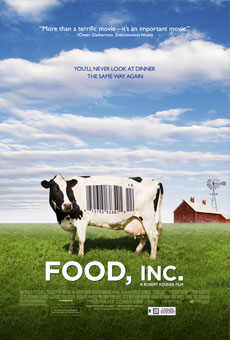 This weekend, partly out of personal interest and partly in relation to a project I'm working on for the CWRL, I saw the new documentary Food, Inc. What follows is a brief "review" of the film (in other words, my scattered response to it) and some ideas for incorporating the film in the classroom (I assume it will be released on DVD sometime in the fall). I won't be discussing the visual rhetoric of the film in depth, but will instead focus on the film as the visual presentation of an argument about food.
This weekend, partly out of personal interest and partly in relation to a project I'm working on for the CWRL, I saw the new documentary Food, Inc. What follows is a brief "review" of the film (in other words, my scattered response to it) and some ideas for incorporating the film in the classroom (I assume it will be released on DVD sometime in the fall). I won't be discussing the visual rhetoric of the film in depth, but will instead focus on the film as the visual presentation of an argument about food.
*****
The opening credits of Food, Inc. present viewers with a tour of the modern American supermarket and the cornucopia of brightly colored packages filling it. The audience is later informed by voiceover narration that this supermarket contains somewhere around 47,000 products. In one of the film's more sardonic moments, we are also informed that an astonishingly high number of these products are made with elements derived from a single ingredient: corn. This arc covered by the film, from the universal supermarket to the particular kernel, establishes its intention of uncovering the origins of the American food supply. Food, Inc. tells the story of industrial agriculture for an audience that, it presumes, is largely unfamiliar with where (or what), exactly, its next meal is coming from.
Recent comments
2 years 29 weeks ago
2 years 44 weeks ago
2 years 44 weeks ago
2 years 50 weeks ago
3 years 4 weeks ago
3 years 4 weeks ago
3 years 4 weeks ago
3 years 6 weeks ago
3 years 6 weeks ago
3 years 6 weeks ago